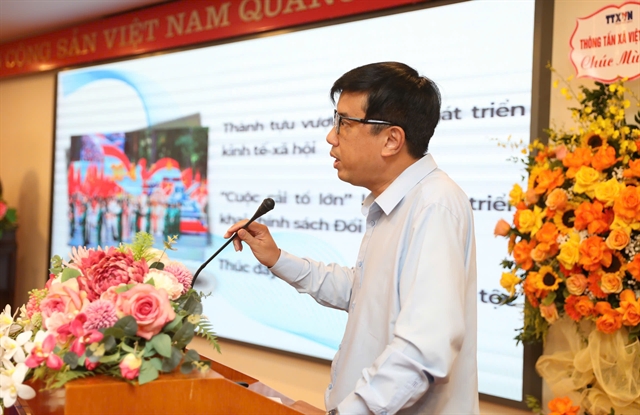 Society
Society

 |
| Nguyễn Trường Sơn, editor-in-chief of The World and Vietnam Report, speaks at the event. VNS Photo Đoàn Tùng |
HÀ NỘI — As the fourth industrial revolution picks up steam globally, with intense competition between countries, national image-building must now seek out a unique identity to position itself well and compete with other brands, said Nguyễn Trường Sơn, editor-in-chief of The World and Vietnam Report at a roundtable on promoting the nation's image in the new era.
The event was co-hosted on Thursday by Vietnam News Agency's Việt Nam News and Law and the Department of Grassroots and External Information under Ministry of Culture, Sports and Tourism.
Sơn said Việt Nam has been praised for its unique method of delegation diplomacy, where high-level visits often include cultural experiences, such as street tours and coffee outings, reflecting Vietnamese hospitality and cultural identity.
“Nowadays, it is rare for a head-of-state visit to Việt Nam not to include informal diplomatic activities — such as sharing a cup of coffee, strolling through the streets or visiting a local establishment. These moments, though seemingly casual, serve as powerful tools for promoting Việt Nam’s national brand and cultural identity,” he said.
However, Việt Nam’s external communication still lacks flexibility and often focuses only on what we want to show, rather than adapting messages for foreign audiences, he said.
He cited statistics from the former Department of External Information revealing that most consumers of foreign-language media in Việt Nam are Vietnamese. The reach among foreigners remains limited.
One of the major challenges today is the increasingly complex global and regional landscape. In many cases, especially during international conflicts, information has become a strategic battleground, he said.
“In this context, promoting the national image must have strong appeal. We need to identify and communicate what makes Việt Nam truly unique and position ourselves competitively among other nations' brands”.
He proposed mobilising external resources in boosting Việt Nam’s reputation around the world.
With over six million people living abroad, the Vietnamese diaspora represents a powerful and indispensable platform for promoting Việt Nam’s image globally. Engaging with this community is not just about communication; it is about sharing cultural identity, fostering national pride and empowering them to become ambassadors of the Vietnamese brand, he said.
“It is vital to recognise the roles of ministries and agencies, especially Việt Nam’s overseas diplomatic missions. If we rely solely on internal capacity, our efforts will remain limited. However, if we can effectively leverage the resources of international partners and host countries, the impact could be transformative,” he said.
Đoàn Đức Thuận, deputy director of Institute for Brand and Competitiveness Strategy, said Việt Nam’s brand positioning should be shaped by three key actors: the State, the people and the business community.
Media must ensure coherent messaging that reflects the connection between land, people and enterprises. Meanwhile, people build the national image through behaviours, values and qualities that generate trust. Every individual can act as a brand ambassador.
Director of the Korean Cultural Centre in Việt Nam Choi Seung Jin shared his country’s experience in national branding.
He said nation branding is a long-standing and critical concern for the Republic of Korea (RoK). RoK has applied direct and indirect policies to promote national branding.
Since 2018, RoK's Ministry of Culture, Sports and Tourism has regularly surveyed international perceptions of the country, using these insights to craft region-specific and time-appropriate strategies. RoK established a National Image Committee and strengthened public diplomacy through digital platforms.
Indirect promotion includes the establishment of the Korea Foundation for International Cultural Exchange since 2010, and expansion of Korean cultural centres abroad since the 1990s.
“Both direct and indirect approaches are essential, but identifying long-term, strategic priorities is particularly crucial,” he said. VNS




